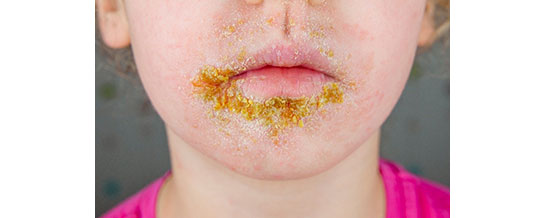How to Care for Your Child with Impetigo
This leaflet will provide you with information about Impetigo causes, symptoms, diagnosis, treatment and home care advice

What is Impetigo?
Impetigo is a skin infection that can affect children of all ages, particularly younger children.
It spreads to other healthy children through close contacts, such as group play.
It usually occurs in warm, moist, and humid conditions
What are the causes of Impetigo?
It is caused by bacteria from the family of staphylococcus and streptococcus.
These bacteria enter healthy skin through openings caused by minor scrapes and bites.
What are the symptoms of Impetigo?
Impetigo evolves through different stages. It starts as an area of inflamed skin followed by small red bumps that become blisters filled with yellowish-whitish fluid. These blisters eventually rupture and become crusted.
How is Impetigo diagnosed?
Your doctor will diagnose Impetigo by looking at the skin.
How is Impetigo treated?
Impetigo is treated with antibiotics in the form of an ointment, liquid/pill or both for 7 to 10 days. Your doctor will make a choice based on the extent of the infection.
- If the infection is localized to a small area, your doctor may prescribe a local antibiotic ointment
- If the infection is widespread, your doctor may prescribe oral antibiotics.
Home care advice
- Use antibiotics as recommended by your doctor
- wash hands with soap and water regularly
- Wash the clothes, towel, and other linens in hot water
- Cover infected skin parts with loose clothing and avoid scratching them
- Avoid group sports until your child is completely recovered.
When should I seek medical advice?
Seek medical advice if:
- Your child has a fever greater than 38 Celsius
- The Impetigo is not improving after two days of treatment.
- The Impetigo is spreading despite treatment
- You notice increasing discharge from the lesions
Go to the Emergency Department if your child:
- Is vomiting and has poor appetite.
- Has pain, swelling, and redness around the area of Impetigo
- Changes in behaviour, like confusion or become more irritable

